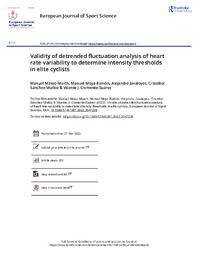Por favor, use este identificador para citar o enlazar este ítem:
https://hdl.handle.net/11000/35248
Validity of detrended fluctuation analysis of heart
rate variability to determine intensity thresholds
in elite cyclists
 Ver/Abrir: 6.pdf
Ver/Abrir: 6.pdf1,7 MB
Adobe PDF
Compartir:
Título :
Validity of detrended fluctuation analysis of heart
rate variability to determine intensity thresholds
in elite cyclists |
Autor :
Mateo March, Manuel 
MOYA-RAMÓN, MANUEL 
Javaloyes, Alejandro 
Sánchez-Muñoz, Cristobal
Clemente-Suárez, Vicente J. |
Editor :
Wiley |
Departamento:
Departamentos de la UMH::Ciencias del Deporte |
Fecha de publicación:
2022-03-27 |
URI :
https://hdl.handle.net/11000/35248 |
Resumen :
Background: The evaluation of performance in endurance athletes and the subsequent
individualisation of training is based on the determination of individual physiological thresholds
during incremental tests. Gas exchange or blood lactate analysis are usually implemented for
this purpose, but these methodologies are expensive and invasive. The short-term scaling
exponent alpha 1 of detrended Fluctuation Analysis (DFA-α1) of the Heart Rate Variability (HRV)
has been proposed as a non-invasive methodology to detect intensity thresholds. Purpose: The
aim of this study is to analyse the validity of DFA-α1 HRV analysis to determine the individual
training thresholds in elite cyclists and to compare them against the lactate thresholds.
Methodology: 38 male elite cyclists performed a graded exercise test to determine their
individual thresholds. HRV and blood lactate were monitored during the test. The first (LT1 and
DFA-α1-0.75, for lactate and HRV, respectively) and second (LT2 and DFA-α1-0.5, for lactate and
HRV, respectively) training intensity thresholds were calculated. Then, these points were
matched to their respective power output (PO) and heart rate (HR). Results: There were no
significant differences (p > 0.05) between the DFA-α1-0.75 and LT1 with significant positive
correlations in PO (r = 0.85) and HR (r = 0.66). The DFA-α1-0.5 was different against LT2 in PO (p
= 0.04) and HR (p = 0.02), but it showed significant positive correlation in PO (r = 0.93) and HR (r
= 0.71). Conclusions: The DFA1-a-0.75 can be used to estimate LT1 non-invasively in elite
cyclists. Further research should explore the validity of DFA-α1-0.5.
|
Palabras clave/Materias:
thresholds
heart rate variability
elite cyclists
nonlinear analysis |
Área de conocimiento :
CDU: Bellas artes: Diversiones. Espectáculos. Cine. Teatro. Danza. Juegos.Deportes |
Tipo de documento :
info:eu-repo/semantics/article |
Derechos de acceso:
info:eu-repo/semantics/openAccess |
DOI :
https://doi.org/10.1080/17461391.2022.2047228 |
Publicado en:
European Journal of Sport Science |
Aparece en las colecciones:
Artículos Ciencias del Deporte
|
 La licencia se describe como: Atribución-NonComercial-NoDerivada 4.0 Internacional.
La licencia se describe como: Atribución-NonComercial-NoDerivada 4.0 Internacional.
 La licencia se describe como: Atribución-NonComercial-NoDerivada 4.0 Internacional.
La licencia se describe como: Atribución-NonComercial-NoDerivada 4.0 Internacional.
.png)
